Final report for EW16-029
Project Information
Herbicide resistance (HR) in weeds is a threat to the sustainability and profitability of the Northern Great Plains (NGP) agriculture. Growers and ranchers need awareness and training on mitigating HR issues on their farm through adoption of Best Management Practices (BMPs). The main goal of this project was to enhance the knowledge of agricultural professionals on HR weed evolution, dynamics, socio-economic impacts, and mitigation through incorporation of BMPs. This educational project will take place in 3 different phases. During 2016 and 2017, we completed Phase 1 (Course Development) and Phase 2 (Instruction) of this regional project. The major accomplishments/milestones have been provided in the report. Phase 3 (Evaluation) was initiated in the second year (2017) and was accomplished by March 2018 to evaluate the acquired change in knowledge, outreach to growers and ranchers, and long-term gains on the awareness of HR and BMPs.
Objective 1: Course Development (Completed)
- Major activities: Photographs and details on major herbicide-resistant (HR) weeds of NGP, HR weed infestations on farm fields, frequency and distribution maps at the State/County level, and related research results on HR weed surveys will be compiled into extension bulletin, fact sheets, oral/poster presentations
- Sustainable BMPs for managing HR kochia through past and current research projects at the MSU Southern Ag Research Center and other published work in the region will be utilized for the development of fact sheets and oral and poster presentations
- Printing these educational materials and development of web-based training modules
Objective 2: Instruction (Completed)
- Major activities: Classroom instruction, Field days, and workshops for Ag Professionals
- CCA seminars, on-site demonstrations, surveys
- Field instruction for Ag. Professionals
Objective 3: Evaluation (Completed)
- Main activities: Interactive Workshop
- Follow-up surveys
- Evaluation of knowledge gained by Ag Professionals
Recently, growers and ranchers in the Northern Great Plains (NGP) have reported escalating cases of herbicide-resistant (HR) weeds in their farm fields. HR weeds and their management have considerable economic impacts on production agriculture and natural resource conservation in the region.
Glyphosate (burndown), ACCase-inhibitors (Group 1), ALS-inhibitors (Group 2), and synthetic auxins (Group 4) are the most commonly used herbicide chemistries in no-till dryland cereal-based production systems of the NGP. Wild oat resistant to Group 1 herbicides is widespread across the NGP cereal belt. Wild oat resistance to Group 2 herbicides has also been documented (Heap 2015). Recently, wild oat strains with multiple resistance to Group 1, group 2, and difenzoquat have been reported in Montana (Keith et al. 2015). Green foxtail resistance to ACCase-inhibitors has also been reported in this region. Prickly lettuce biotypes resistant to Group 2 and Group 4 (2,4-D, dicamba, and MCPA) are known to occur in wheat fields (Heap 2015). Russian thistle has developed resistance to Group 2 herbicides used in wheat (Heap 2015). The recent evolution of glyphosate-resistant kochia and Russian thistle is a potential threat to the no-till wheat-fallow and glyphosate-resistant cropping systems of this region (Kumar et al. 2014, 2015, 2017). Kochia with multiple resistance to glyphosate, dicamba and Group 2 herbicides is a challenge for the growers and ranchers in Montana, Wyoming and adjacent states (Jha et al. 2013).
The best management practices (BMPs) for HR weed management are established on the concept of “diversity”. Mitigating HR will depend on reducing selection pressure by diversification of weed control tactics, reducing the spread of resistance alleles via pollen or seed, and preventing weed seed bank additions (Norsworthy et al. 2012). Farmers are reluctant to change their weed control practices or adopt proactive HR management programs because of their interest in short-term economic returns and lack of awareness on evaluating the economic risks associated with HR weeds until resistance has evolved in their production fields (Beckie 2006). Growers should not expect many new sites of action to be commercialized in the near future. Keeping this in mind, the existing herbicide tools need to be saved for future generations, which would be only possible by incorporating multi-tactic tools and ecologically-based weed management strategies including cover crops, diverse crop rotations, etc.
Successfully managing herbicide resistance would require collaboration and information from multiple disciplines. There needs to be a strong linkage between innovation (discovery of new technology), adoption (actual use of technology by producers), and diffusion (percentage of producers utilizing the new technology or percentage of farm dedicated to changed practice) of IWM technologies and BMPs. The Ag professionals need training and improved knowledge to disseminate this information and awareness among growers, which is currently lacking.
The main objectives of this project were: (1) to educate agricultural (Ag) professionals in understanding the evolution, biology, frequency, geographical distribution, and socio-economic impacts of HR weeds, and (2) to implement and promote the BMPs for HR weed management and sustainable agriculture in the NGP.
Cooperators
- (Researcher)
- (Educator)
- (Educator)
Education
Objective 1: Course Development
Research-based educational materials (posters, oral presentations, extension bulletin, and fact sheets) on Occurrence of HR Weeds in NGP: Frequency, Distribution, and Socio-Economic Impacts, Long-Term Implications of Best Management Practices (BMPs) for Mitigating HR in NGP and on other similar topics were developed during the first 12-month period of the project. Faculty, professionals, and post-doctoral researchers from Montana State University Southern Agricultural Research Center, and MSU Extension were involved in preparing these educational materials. During this initial phase of the project, information on biology of problem HR weed species in the NGP region, historical perspectives of HR weeds in NGP, geographical distribution and frequency of HR weed occurrence, current HR management programs, evaluation and implementation of BMPs for mitigating HR, and the socio-economic risk/benefits of adoption of BMPs were compiled from previous and current research projects at MSU, UWY and other published literature in this western region.
During 2016-2018, HR weed surveys were conducted in MT-WY irrigated and dryland cropping systems to determine the distribution of HR weeds. A survey of 25 crop consultants were conducted in 2017 to evaluate the current growers’ knowledge on HR weed management. Information on farm management practices such as cropping sequence, weed control practices, occurrence of HR weeds on farm fields, herbicide use pattern, crop rotation, and knowledge of current and future IWM technologies were collected. A similar follow-up survey of crop consultants was conducted at the end of the project (2018) to assess the impact of the educational programs on the knowledge of Ag professionals and grower adoption of BMPs at the farm level and beyond.
In addition, a web-based tool at MSU Southern Ag Research Center website in uner development to provide research-based information to Ag professionals and other stakeholders. This web tool will be updated on a regular basis and will help to improve the knowledge and training of Ag professionals on HR mitigation and appropriate BMP adoption.
Objective 2: Instruction
The educational materials developed in objective 1 were utilized to train Ag professionals in 2016-2018. Educational programs including workshops, CCA seminars, grower presentations, and field days were conducted during 2016, 2017, and 2018. Ag professionals from different agencies that advise growers on crop management practices were selected, which include United States Department of Agriculture-National Resource Conservation Service (USDA-NRCS), University Cooperative Extension, State Department of Agriculture, University Faculty and Staff, and Crop Consultants. The pool of Ag professionals from various disciplines such as agronomy, horticulture, weed science, and 4-H were selected.
A systematic approach using educational materials (extension bulletin, fact sheet, oral and poster presentations) and knowledge tests were utilized to educate and train Ag professionals. A regional herbicide resistance workshop was coordinated by the PI and other project coordinators on Feb 2018 at the Southern Ag. Research Center, Huntley, MT, where speakers across the northern and southern Great Plains were invited to share their experience and expertise with the Ag Professionals.
Objective 3: Evaluation
Workshops, classroom seminars, and survey questionnaires were developed to test the knowledge of Ag professionals participating in this training program. Similarly, growers’ feedback on the problem of HR and adoption of BMPs were collected to evaluate the impact of this project (2018). The PI and major project participants directly contacted growers, ranchers, and other landowners to collect feedback. The educational materials developed in this project will also be sent to USDA-NRCS, Regional Extension field offices throughout the region for easy access of the information by the growers and general public. A final evaluation was conducted after the Feb 7, 2018 workshop. A total of 65 participants attended this workshop, including crop consultants, Coop. agronomists, Ag. retailers, and extension agents from MT and WY.
Education & Outreach Initiatives
To enhance the knowledge of agricultural professionals on herbicide-resistant weed evolution, dynamics, socio-economic impacts, and mitigation through incorporation of Best Management Practices (BMPs) using a multi-tactic approach
The education and outreach initiatives have been described in the previous section.
Ag professionals serve as first line of contact for any inquiry or new Ag-related information required by the growers/land managers. They have the ability to effect the mindset of broad range of landowners by acquiring knowledge on sustainable methods of pest control. The information generated from this project was disseminated region wide. We expect that the outcomes of this educational project will also impact other US states where HR is an increasing threat to sustainable agriculture.
At the end of the final workshop conducted in February 2018, a survey in the form of a questionnaire was conducted to evaluate the impacts of this project: 1) How this project changed the knowledge of the Ag professionals on HR mitigation through implementation of BMPs? 2) What would be the success rate in disseminating the knowledge and information by the Ag professionals to the producers and farming community? 3) What were the economic risks/benefits of adopting BMPs for HR mitigation as perceived by the Ag professionals? 4) How Ag professionals can further utilize this information and improved knowledge to solve other pest management issues, e.g. long-term implications of this project for sustainable and integrated pest management? Based on the final evaluation, there was a clear indication of enhanced knowledge of Ag professionals (project participants) on escalating cases of HR weed occurrence in farm fields, socio-economic impacts, and methods to implement BMPs for HR prevention and mitigation in the NGP agriculture.
Through these outreach programs, we can expect that Ag professionals from different agencies and general public will become more aware on the HR weed evolution and sustainable BMPs for HR mitigation, and will follow the progress of on-going research and extension projects on HR regionally. Based on the evaluation, the training and educational materials (extension bulletin, fact sheet, oral and poster presentations, web-based information) generated were much needed for the Ag professionals to further spread the acquired knowledge to landowners and general public.
Educational & Outreach Activities
Participation summary:
Learning Outcomes
Project Outcomes
Since April 1, 2016 (start of the grant cycle), we achieved Objectives 1 (Course Development) and Objective 2 (Instruction). To fulfill Objective 1, we have compiled reports on major herbicide-resistant weeds in the NGP, their biology, and distribution at the state/County level. Sustainable Best Management practices (BMPs) for managing HR weeds through past and current research projects at the MSU Southern Ag Research Center and other published work in the region were utilized for the development of educational materials for Ag professionals and project participants. Socio-economic risk/benefits of adoption of BMPs were compiled from previous and current research projects at MSU and other published literature in this region. We prepared and distributed a survey questionnaire to Ag. Professionals in MT-WY region (mostly crop consultants) to evaluate their current knowledge on HR weed management. Information on farm management practices such as cropping sequence, weed control practices, occurrence of HR weeds on farm fields, herbicide use pattern, and grower knowledge of current and future IWM technologies were collected in this survey. There were a total of 50 participants in this survey. We have developed a Facebook Page @ SouthernAgResearchCenter which will help to improve the knowledge and training of Ag professionals on herbicide-resistance research, mitigation and appropriate BMP adoption.
To fulfill Objective 2, a series of oral presentations at MSU Fields Days and regional grower meetings were delivered by the PI and other project coordinators to educate Ag. Professionals on herbicide resistance issues in MT and adjacent states and strategies and upcoming technologies to mitigate herbicide resistance on-farm. Plot demonstrations were also conducted during 2016, 2017, and 2018 field days and CCA tours across the region. These fields days were attended by growers and Ag professionals from different agencies that advise growers on crop management practices such as USDA-NRCS, University Cooperative Extension, State Department of Agriculture, University Faculty and Staff, and Crop Consultants, and Extension agents. Ag professionals from various disciplines such as agronomy, horticulture, weed science, and 4-H attended these grower meetings and presentations. Peer-reviewed journal articles were also published during 2016, 2017, and 2018 and added to the reports that will be shared with the Ag. Professionals. A major milestone was that we organized a “Great Plains Herbicide Resistance Listening Session” on February 17, 2017 at Holyoke, CO, that was attended by 150 Ag. Professionals from MT, WY, NE, CO, and KS. In addition, a "Herbicide resistance workshop" attended by 65 participants was organized at the MSU-SARC facility on Feb 7, 2018 as part of the final evaluation. Based on the evaluation results, there was an increase in the knowledge and awareness on herbicide resistance and adoption of BMPs by the trained Ag Professionals.
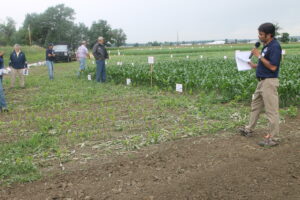
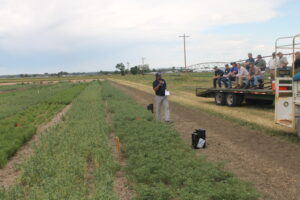
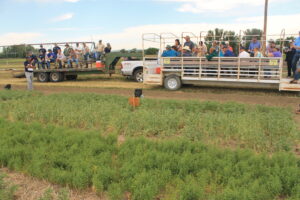
Major milestones during this grant period have been listed below:
Peer-Reviewed Articles on Herbicide Resistance and Management: Printed copies distributed to Ag professionals
- Kumar, V., Jha, A. Dille, and P. W. Stahlman. 2018. Emergence dynamics of kochia (Kochia scoparia) populations from the US Great Plains: A multi-site-year study. Weed Science. 66 (1):25-35.
- Kumar, V. and Jha. 2017. First report of Ser653Asn mutation endowing high‐level resistance to imazamox in downy brome (Bromus tectorum L). Pest Management Science. DOI:10.1002/ps.4673.
- Jha, P., and V. Kumar. 2017. Pulse crop tolerance and weed control with fall-applied soil-residual herbicides. Agronomy Journal. 109:1-11.
- Kumar, V., Jha, and A. J. Jhala. 2017. Confirmation of glyphosate-resistant horseweed (Conyza canadensis L.) in Montana cereal production and response to POST herbicides. Weed Technology. 31:799-810.
- Kumar, V., J. Felix, D. Morishita, and Jha. 2017. Confirmation of glyphosate-resistant kochia (Kochia scoparia L.) from sugar beet fields in Idaho and Oregon. Weed Technology. doi:10.1017/wet.2017.80.
- Shaw, J., Jha, P. Nugent, A. Donelick, B. Scherrer, and V. Kumar. 2017. Discrimination of herbicide-resistant weeds with hyperspectral imaging. Journal of Applied Remote Sensing. Accepted (In press).
- Jha, P., V. Kumar, R. K. Godara, and B. S. Chauhan. 2017. Weed management using crop competition in the United States: A review. Crop Protection. 95:31-37.
- Kumar, V., J. F. Spring, Jha, D. J. Lyon, and I. C. Burke. 2017. Glyphosate-resistant Russian-thistle (Salsola tragus L.) identified in Montana and Washington. Weed Technology. 31:238-251.
- Kumar, V., Jha, P. (2016). Growth and Reproduction of Glyphosate-Resistant and Susceptible Populations of Kochia scoparia. PloS one, 11(1).
- Jha, P., Kumar, V., Lim, C. A. (2016). Herbicide resistance in cereal production systems of the US Great Plains: A review. Journal of Weed Science, 48(2), 112–116.
- Reddy, K. N., Jha, P. (2016). Herbicide-resistant weeds: Management strategies and upcoming technologies. Journal of Weed Science, 48(2), 108–111.
- Kumar, V., Jha, P. (2016). Influence of Nitrogen Rate, Seeding Rate, and Weed Removal Timing on Weed Interference in Barley and Effect of Nitrogen on Weed Response to Herbicides. Weed Science. 65: 189-201.
- Gaines, T. A., Barker, A. L., Patterson, E. L., Westra, P., Westra, E. P., Wilson, R. G., Jha, P., Kumar, V., Kniss, A. R. (2016). EPSPS Gene Copy Number and Whole-Plant Glyphosate Resistance Level in Kochia scoparia. PloS one, 11(12), e0168295.
- Kumar, V., Jha, P. (2016). Differences in Germination, Growth, and Fecundity Characteristics of Dicamba-Fluroxypyr-Resistant and Susceptible Kochia scoparia. PloS one, 11(8), e0161533.
Oral/Poster Presentations at Grower Meetings/Field Days/CCA seminars:
- Simplot Grower Meeting, "Effect of crop rotation, tillage, and herbicide diversity on evolution of herbicide resistance in kochia: Results from a four-year multi-location study", Powell, WY, Feb 27, 2018 (to be presented).
- CCA Field Day, "Status of herbicide resistance in Montana and ecological weed management strategies", Southern Agricultural Research Center, Huntley, MT, August 8, 2017. Participants: 50 (30 Ag professionals including MSU extension agents, MT commodity group members, and crop consultants/industry reps; 8 MSU extension and research faculty; 12 growers)
- Malt Barley and Sugar Beet Symposium, "Hyperspectral imaging to detect herbicide-resistant weeds in-crop", Billings, MT, Jan 10-11, 2017. Participants: 150 (50 Ag professionals including MSU extension agents, MT commodity group members, and crop consultants/industry reps; 20 MSU extension and research faculty; 70 growers; 10 researchers)
- Crop and Pest Management School, "Precision weed management in Montana cropping systems", Bozeman, MT, Jan 3, 2017. Participants: 80 (15 Ag professionals including MSU extension agents, MT commodity group members, and crop consultants/industry reps; 10 MSU extension and research faculty; 45 growers; 10 researchers)
- CHS Grower Meeting, "Herbicide resistance management in the US Great Plains", Malta, MT, Jan 9, 2017. Participants: 45 (20 Ag professionals including MSU extension agents, MT commodity group members, and crop consultants/industry reps; 5 MSU extension and research faculty; 15 growers; 5 general public)
- MSU Post Farm Field Day, "Advanced optical sensor-based hyperspectral imaging and spot spray technologies for precision weed control and HR weed management in fallow and in-crop", Montana Agricultural Experiment Station, Bozeman. (July 7, 2016). Participants: 90 (20 Ag professionals including MSU extension agents, MT commodity group members, and crop consultants/industry reps; 15 MSU extension and research faculty; 45 growers; 10 general public)
- MSU Southern Agricultural Research Center Field Day, "Integrated weed management in dryland and irrigated cropping systems of Montana and precision weed control technologies", DRC-SARC, Huntley. (June 28, 2016). Participants: 105 (40 Ag professionals including MSU extension agents, MT commodity group members, and crop consultants/industry reps; 50 growers; 15 MSU researchers and extension specialists, and graduate students/postdocs and general public)
- MSU Eastern Agricultural Research Center Field Day, "Weed control options for herbicide resistance management in pulse crops in eastern MT", DRC-EARC, Sidney MT. (June 24, 2016). Participants: 80 (20 Ag professionals including MSU extension agents, MT and ND commodity group members, and crop consultants/industry reps; 50 growers; 10 MSU and NDSU researchers and extension specialists, graduate students/postdocs/general public)
- MSU Northern Agricultural Research Center Field Day, "Fall-applied soil residual herbicides in wheat stubble and rotational crop safety and weed control in pulse crops", DRC-NARC, Havre, MT. (June 22, 2016). Participants: 120 (40 Ag professionals including MSU extension agents, MT commodity group members, and crop consultants/industry reps; 60 growers; 20 MSU researchers and extension specialists, graduate students/postdocs/staff/general public)
- Divide County Crop Improvement Meeting, "Management of glyphosate-resistant weeds in wheat-pulse rotation", Crosby, ND. (September 21, 2016). Participants: 50 (20 Ag professionals including MSU and NDSU extension agents, crop consultants, and industry reps; 25 growers; 5 MSU/NDSU researchers and extension specialists)
- MSU Western Triangle Research Center Field Day, "Integrated strategies to manage herbicide resistance in dryland, cereal production systems of the Golden Triangle", DRC-WTARC, Conrad MT. (June 23, 2016). Participants: 85 (30 Ag professionals including MSU extension agents, crop consultants, and industry reps; 40 growers; 15 MSU researchers and extension specialists, students, and staff)
- Annual Sugar Beet Growers' Research Meeting, "Integrated strategies for kochia management in Roundup Ready® sugar beet", Western Sugar Coop., Colorado Springs, CO. (January 2016). Participants 50 (20 Industry reps, crop consultants, and agriculturists; 15 growers; 15 researchers, and university staff from MT, WY, NE, and CO)
Surveys
- Survey, "Consultant perspectives on herbicide resistance in the region and weed management needs", MT and northern WY. (2017). Partcipants: crop consultants and Ag. retailers
- Statewide Survey, "Statewide survey of glyphosate-resistant kochia, Russian thistle, and marestail (horseweed) from grower fields in Montana", Montana. (2016-2017). Participants: Ag professionals including MSU extension agents; crop consultants; growers
- Regional Survey, "Survey of glyphosate-resistant kochia in sugar beet fields in MT, WY, CO, and NE", Western Sugar Coop., MT and WY. (2016 and 2017). Participants: Ag professionals including MSU extension agents; crop consultants; growers
Media Contributions
- Montana Ag Live/Montana PBS Live TV Show (TV), October 16, 2016 Description: Emphasis on herbicide resistance issues in Montana, precision agriculture and site-specific weed management using optical sensors and hyperspectral imaging.
- AGWEEK (Internet), March 4, 2016. Description: First report on glyphosate-resistant Russian thistle in Montana wheat-fallow system.
Fact sheets and educational/extension publications:
10 fact sheets were distributed during various educational events
4 extension articles were published (will be available online soon).
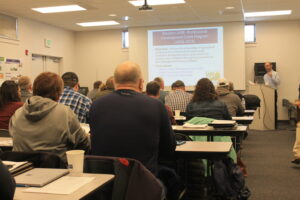
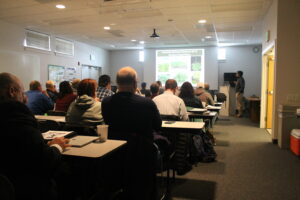

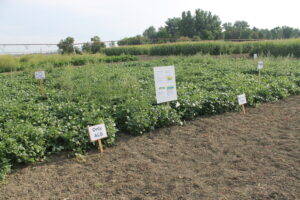


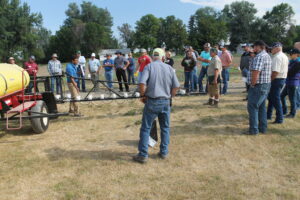

Changes in knowledge or attitude as a result of this project:
- The 600 target audience (participants) which include growers, crop consultants, Extension agents, agronomists, Ag. retailers in MT-WY region gained better understanding of the factors contributing to herbicide resistance development in weed species specific to the cropping systems of the Northern Great Plains.
- As a result of this educational project, there was an increase in knowledge and awareness on utilizing integrated weed management practices to mitigate herbicide resistance; for instance, utilizing diverse crop rotations, strategic tillage, cover crops etc. Diversity is the key.
- Several farmers in the Northern Grain Belt of Montana reported a change in their production practice from continuous wheat-fallow systems (vulnerable to development of herbicide resistance) to wheat-pulse rotations- bringing more sustainability, profitability, and diversity at a systems level.
- Since 2016, more than 100 growers in Montana adopted conservation tillage or strategic tillage (at least once in the growing season) to deplete weed seed banks and reduce reliance on herbicides in no-till chemical fallow. Some of those growers have adopted cover crops in the fallow phase of the wheat-fallow rotation for improved soil health and reduced pesticide use.
- Over the last two years, almost 60% of Montana growers facing the challenge of glyphosate- and dicamba-resistant kochia in their farm have adopted fall-applied soil residual herbicide programs to reduce the selection pressure from glyphosate and other burndown POST herbicides in wheat-based cropping systems.
- Growers and land managers reported an improved understanding of the value of preventing influx of herbicide resistance from field edges and ditch banks and a better understanding of weed biology and weed seed banks for managing weed populations in their fields.
- During the evaluation phase of this project, MSU extension agents and crop consultants mentioned that this was a much needed educational program to develop long-term strategies for dealing with herbicide resistance challenge and that there was a lack of university extension in this area prior to this initiative. The workshops conducted by the PI and his team provided a unique opportunity for growers, crop consultants, chemical industry, commodity groups, NRCS and other govt agencies to stimulate a broader discussion of more innovative ways to address the threat posed by herbicide resistant weeds in the Great Plains.
- As an outcome of this project, there was a common consensus that herbicide resistance is a complex problem, and there is a need for collaboration of weed scientists, crop consultants, economists, and sociologists to examine interdisciplinary aspects and human dimensions of this problem- a path forward.
Herbicide resistant weeds are currently a challenge to the sustainability of major cropping systems in the U.S. This Western SARE PDP grant program provided a unique platform to provide training, education, and resources to ag professionals to build their awareness, knowledge and skills related to herbicide resistance mitigation using integrated pest management (IPM) tools, with the ultimate goal of reducing the pesticide load in the environment and attaining sustainable agriculture in the western region. It was an effective means to focus our coordinated efforts in research and extension in the area of herbicide resistance management. Although solutions to herbicide resistance are often complex and are mediated by many biological, ecological, economic, regulatory, and social factors, stakeholders need more information, training and solutions to address these challenges through effective training and educational programs at a multidimensional level. More funding for conducting statewide and region-wide extension programs in the area of Integrated Pest Management (IPM) is needed to mitigate herbicide resistance issues at an agroecosystem level as recognized by the project participants and Ag professionals.